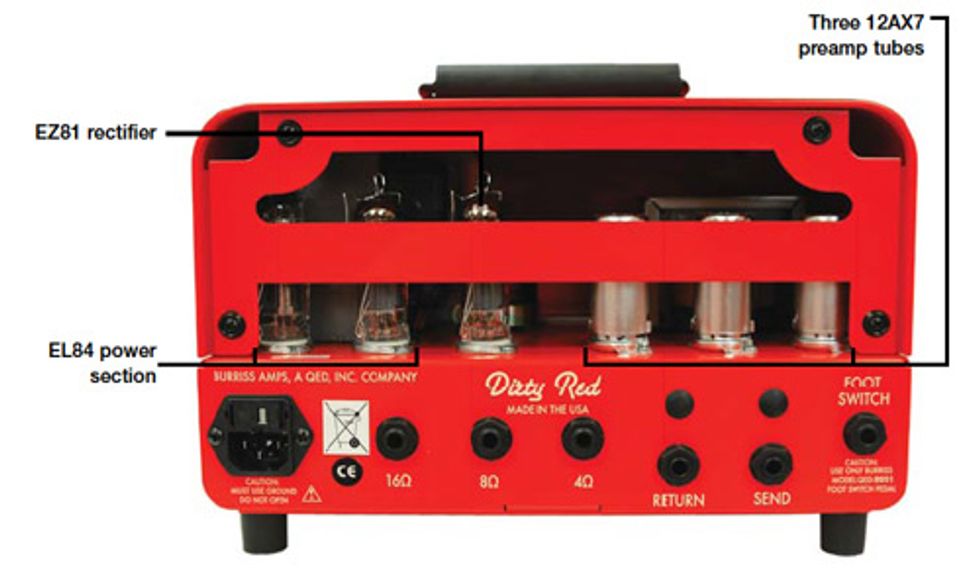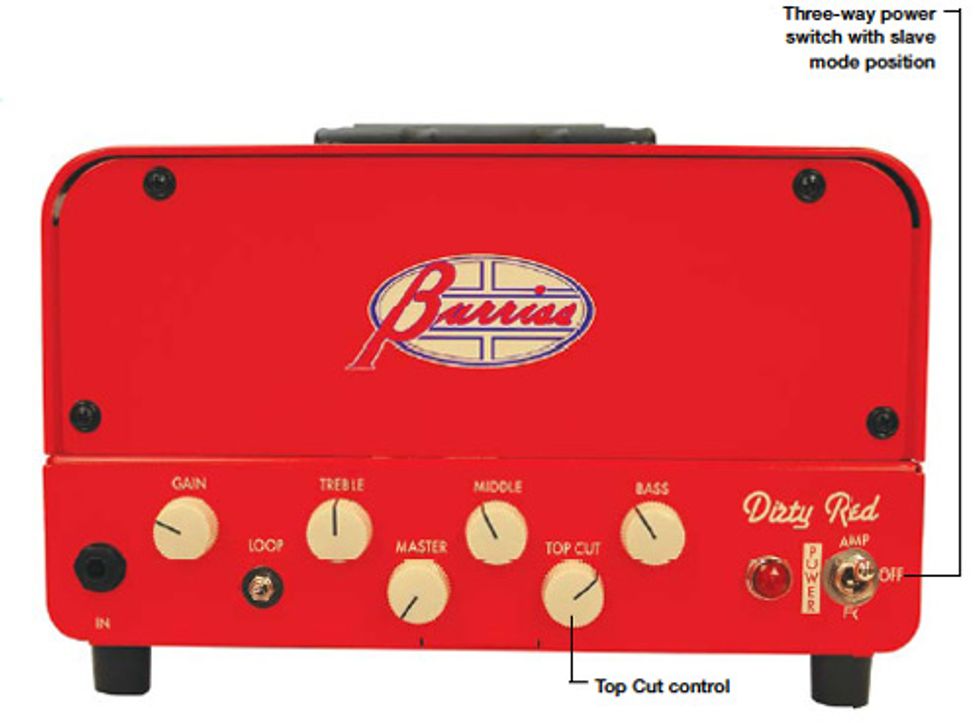| Download Example 1 Max Gain | |
| Download Example 2 Dirty | |
| Clips recorded with a 2008 Gibson Les Paul Studio into a Diezel 2x12 cabinet. | |
Given the competition that’s heated up as a consequence, it takes a really sweet-sounding amp—or a really versatile one—to stand apart from the pack. Burriss, hot off the heels of the release of their popular Royal Bluesman, packs a lot of both qualities in their newest little monster, the 18-watt, EL84-driven Dirty Red. It’s also built around a cascading preamp design that enables higher-gain sounds at lower volume, which gives it the goods to stand tall in the mini-amp crowd.
In the Court of the Crimson King
The Dirty Red is pretty full-featured for such a tiny amplifier. And it looks built for business, inside and out. The little 18-watter is fired by three Mullard reissue 12AX7 preamp tubes, an Electro-Harmonix EZ81 rectifier tube and two JJ EL84 tubes in the power section. The Dirty Red’s all-metal construction feels rugged, but at just under 13 pounds, the amp is surprisingly light.
On the front panel, you’ll find a familiar 3-band equalization section consisting of Bass, Middle, and Treble knobs, along with separate Gain and Master volume controls. But nestled between the Middle and Treble controls, you’ll find another knob called Top Cut. Burriss says the control is designed to tame the high end and warm the signal at higher gain settings. Anyone familiar with a presence control will find it works in a similar fashion. Finally, there’s a Loop switch for engaging the effects loop, which can also be activated using a footswitch inserted into a rear-panel TRS 1/4" jack.
The Dirty Red’s optional Power Loop Pedal footswitch sports a Boss-style power jack designed to run outboard pedals and eliminate the need for extra cords and power supplies that can introduce noise and clutter. This footswitch is capable of delivering 500 mA of juice to as many as 10 pedals. The Dirty Red has another unusual trick up its sleeve, courtesy of its 3-way power switch. The top position turns the amp on and the middle position is off—no surprises here. But the bottom position—dubbed FX— activates a slave mode that effectively lets you run the Burriss as an overdrive unit plugged into an external amplifier. In FX mode, you simply run a shielded cable from the Dirty Red’s effects send to the second amplifier’s input. Clever design considerations like these make the Dirty Red a neat little amp.

Red Hot!
With a name like Dirty Red, it’s a safe guess that this amp excels at high-gain sounds. It does, but the Dirty Red’s mid-gain tones are excellent, too. Using a Diezel 2x12 semi-open-back cabinet with Hempcone speakers, I set up a rig with the Dirty Red, a 2008 Gibson Les Paul Studio, a 2009 Fender American Stratocaster, and a 1978 Gibson Les Paul Custom.
With the Les Paul Studio and the amp’s gain control set to 10 o’clock, the amp was snarling and growling with every pick stroke. Even when backing off the gain significantly, it was kind of hard to dial out the overdrive entirely. And I had better luck getting a clean signal with the Stratocaster, but even then I had to drop the gain to between the 8 and 9 o’clock positions, and crank the master pretty high to get the amp to push any air. It may not be the best amp for super clear, chiming sounds or transparent jangle, but the mild overdrive tones are sweet enough to make you forget this limitation.
The Dirty Red has a great, chewy midrange with just a little grit that makes it a blast to play lead lines. I’ve always judged great amp overdrive by how fat and defined each note is in big firstposition chords. The Dirty Red had those traits in spades, and retains that quality when using a guitar with hotter pickups like my Les Paul Custom with Tom Anderson humbuckers. To retain note-to-note definition, I sometimes had to drop the amp’s gain down a bit to compensate for the added signal, but generally I was able to do so while retaining the personality of the hotter instrument. Cranking the gain made it possible to play around with some pretty aggressive metal riffing. Though the midrange and top end are looser than, say, on a vintage Marshall JCM800 head, the Dirty Red retained the ferocity and vigor of a bigger amp, even at much lower volumes.
The range and responsiveness of each of the Dirty Red’s controls is another impressive aspect of this amp. The Top Cut in particular provides real tone-shaping power and flexibility. Most small-wattage amplifiers don’t have a huge amount of low end, but the Dirty Red certainly does, and its ability to shape the bass was invaluable. I dialed the Bass knob back to noon most of the time, and even when I was really pushing the amp with an aggressive rock riff, I rarely set the Bass control much past 1 o’clock.
The Verdict
Burriss Amps’ Dirty Red is a fantastic sounding and well-rounded amp head by the standards of any wattage class. The equalization range was impressive, yet easy to manage. The amount of volume available was more than enough to carry through a band practice, and most certainly enough to carry through a bar or venue with the help of a good microphone and PA. Its aggressive nature and voicing made it difficult to coax out a pure, sparkling clean tone, but its full-bodied and slightly gritty sound offers the vintage vibe of late-’60s British amplification. If you’re a fan of greasy, low-wattage EL84 tone, but don’t want to have to lug around a hefty combo or stack, mark my words—you’ll want to try the Dirty Red.
Video Review:
Buy if...
you’re after a greasy, small-wattage tone that has mega volume.
Skip if...
you need a rock amp with a fuller, more guttural response or one capable of generating crystal-clear tones.
Rating...
Street $1195 - Burriss Amps - burrissamps.com |






![Rig Rundown: Russian Circles’ Mike Sullivan [2025]](https://www.premierguitar.com/media-library/youtube.jpg?id=62303631&width=1245&height=700&quality=70&coordinates=0%2C0%2C0%2C0)


















